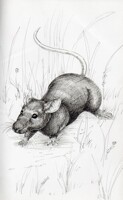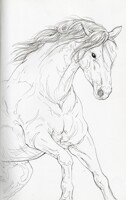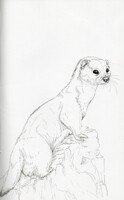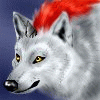
Spirit Guide of the day is Skunk! Stand your ground! Be assertive when necessary and don't let others try to manipulate you. Use direct approaches and honesty to work with those in your life that may have become overbearing. Offer respect and dignity to others while holding it as important for your own self as well. However, if you are taking yourself too seriously, take some time to play and relax to lighten up and remind yourself that you are fine. This may be a good time to explore the uses of scents and essential oils in your sexual lifestyle. The Skunk guide is known for it's connection to respect, self-esteem, and sensuality. The skunk is often given a wide berth of respect by many and shows us how important giving and demanding respect can be. It shows us how to strengthen and assert our own qualities. While skunks are fearless and walk with confidence, they also are naturally peaceful animals. Even the iconic spraying to force threats away has multiple warnings beforehand in order to avoid conflict. We can see this as a meaning to work on distancing yourself from those that are negative for your health and to attempt to live your live as peacefully as possible. Scent is important with the Skunk guide by teaching us to research scents, essential oils, and to awaken our own abilities. The white stripe seen on skunks connects to Kundalini energies. Learn when to speak and how to work with your own energies. People who connect with Skunk are confident and charismatic without being arrogant. These individuals possess the ability to distance those that may mean them harm and have no problems with standing up to defend themselves without getting violent. These playful souls are not easily intimidated and often give off feelings of calm without trying to. They are often attractive to others like them and often prefer to discover their own options rather than being told information by others.
Skunks, Mephitidae, are omnivorous mammals that can live up to 8 years in the wild. Also known as polecats, there are 11 species of Skunk. Two species are found in Indonesia and the Philippines, but most of the species are located in the American continent. While all skunks are striped, they can come in a range of colors from black to grey, brown, cream, and white. The most common species of skunk found in North America is the Striped Skunk such as that featured in this illustration. The spotted, hooded, and hog-nose skunk are less common and the latter two are native only to areas of the Midwest, southwest, and Mexico. These animals are highly adaptable and will live in a wide range of habitats as long as food and shelter can be found. They build their dens in hollowed out logs, brush piles, tree hollows, abandoned animal burrows, and even underneath porches and buildings in more urban areas. However, they generally do not travel more than 2 miles from their den so are sure to pick a home close to a water source. Skunks will usually only dig their own burrow if one is not found available. Skunks have limited sight, but possess excellent hearing and olfactory senses. All skunks have the ability to spray a horrid smelling chemical from glands in their anus which is used as a defensive mechanism to escape predators and other threats. This sulfuric spray can reach up to 10 feet away and be smelled up to 1.5 miles away. This defensive mechanism is only used after a multitude of warning signs such as growling, spitting, shaking its tail, fluffing its fur, and stomping the ground. Skunks will only use their spray as a last resort. They are also immune to snake venom and are even known to eat poisonous snakes such as rattlesnakes. The diet of a skunk consists of insects, grubs, bird eggs, fruits, small rodents, frogs, berries, and mushrooms. They are opportunistic eaters and will adjust their diet according to season, availability, and habitat. They are even known to eat wasps, honeybees, and even attack beehives. These nocturnal creatures will be most active at night and, while they do not hibernate, are often much more inactive during the colder seasons. For warmth, they will sometimes gather in group dens to survive the winter. However, they are solitary the rest of the year and will live and forage on their own. The only other time of the year they will come together is for breeding. Female skunks will give birth around May to babies called kits. These kits are born blind and toothless and will not open their eyes until a few weeks after birth. They are also unable to use their defensive spray until after their eyes open. Kits will remain with their mother for approximately a year when they are old enough to leave and mate.
Skunks, Mephitidae, are omnivorous mammals that can live up to 8 years in the wild. Also known as polecats, there are 11 species of Skunk. Two species are found in Indonesia and the Philippines, but most of the species are located in the American continent. While all skunks are striped, they can come in a range of colors from black to grey, brown, cream, and white. The most common species of skunk found in North America is the Striped Skunk such as that featured in this illustration. The spotted, hooded, and hog-nose skunk are less common and the latter two are native only to areas of the Midwest, southwest, and Mexico. These animals are highly adaptable and will live in a wide range of habitats as long as food and shelter can be found. They build their dens in hollowed out logs, brush piles, tree hollows, abandoned animal burrows, and even underneath porches and buildings in more urban areas. However, they generally do not travel more than 2 miles from their den so are sure to pick a home close to a water source. Skunks will usually only dig their own burrow if one is not found available. Skunks have limited sight, but possess excellent hearing and olfactory senses. All skunks have the ability to spray a horrid smelling chemical from glands in their anus which is used as a defensive mechanism to escape predators and other threats. This sulfuric spray can reach up to 10 feet away and be smelled up to 1.5 miles away. This defensive mechanism is only used after a multitude of warning signs such as growling, spitting, shaking its tail, fluffing its fur, and stomping the ground. Skunks will only use their spray as a last resort. They are also immune to snake venom and are even known to eat poisonous snakes such as rattlesnakes. The diet of a skunk consists of insects, grubs, bird eggs, fruits, small rodents, frogs, berries, and mushrooms. They are opportunistic eaters and will adjust their diet according to season, availability, and habitat. They are even known to eat wasps, honeybees, and even attack beehives. These nocturnal creatures will be most active at night and, while they do not hibernate, are often much more inactive during the colder seasons. For warmth, they will sometimes gather in group dens to survive the winter. However, they are solitary the rest of the year and will live and forage on their own. The only other time of the year they will come together is for breeding. Female skunks will give birth around May to babies called kits. These kits are born blind and toothless and will not open their eyes until a few weeks after birth. They are also unable to use their defensive spray until after their eyes open. Kits will remain with their mother for approximately a year when they are old enough to leave and mate.
Category Artwork (Traditional) / Animal related (non-anthro)
Species Mammal (Other)
Size 818 x 1280px
File Size 316.1 kB

 FA+
FA+








Comments